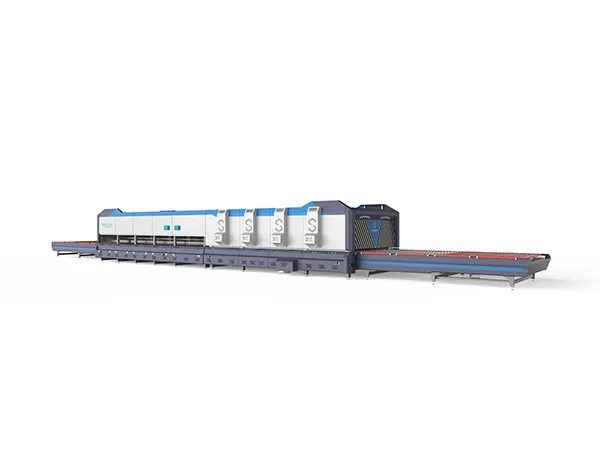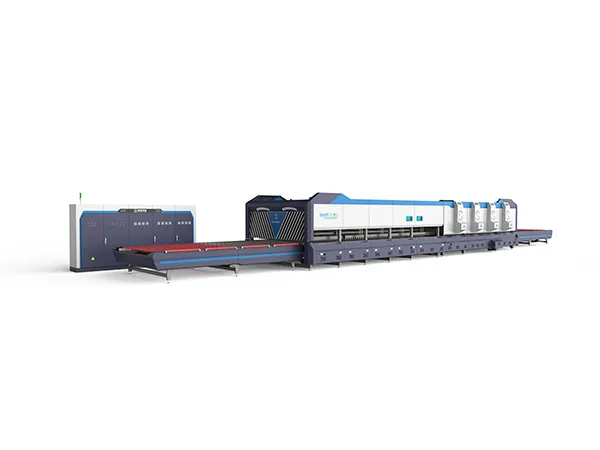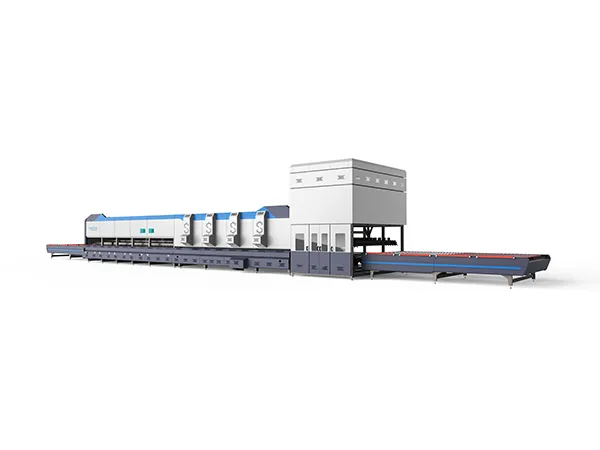Tempering furnaces for the architectural glass industry are designed to meet strict performance, safety, and quality standards. And the key properties of tempering furnaces specifically designed for the architectural glass industry. These furnaces are distinct due to the scale, quality requirements, and types of glass used in buildings.
Performance of tempering furnaces for the architectural glass industry
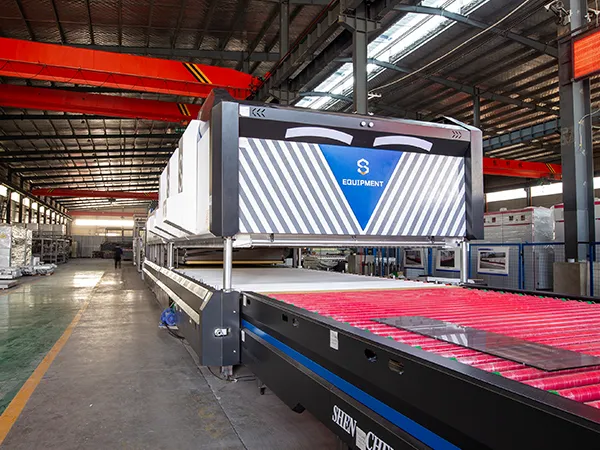
Large Size Capacity:
Architectural glass often comes in large sheets (standard float sizes, jumbo sizes). Furnaces must accommodate dimensions frequently reaching 3.3 meters wide and 6, 7, or even 12+ meters long.
The transport system (rollers) must be robust enough to handle the weight and dimensions of these large lites without causing damage or excessive deflection.
Advanced Convection Heating:
Crucial for Coated Glass (Low-E): Modern architectural glass heavily utilizes Low-E (low-emissivity) coatings for energy efficiency. These coatings reflect infrared heat. Pure radiation heating struggles to heat coated glass evenly and efficiently without overheating the coating.
Forced Convection: These furnaces employ powerful forced convection systems (using heated air) alongside radiation. This allows for:
Faster heating cycles.
More uniform temperature distribution across the glass surface and through its thickness, regardless of coatings.
Reduced risk of overheating and damaging sensitive soft coatings.
Better processing of thicker glass.
Types of Convection: Can be top convection only, or more commonly, top and bottom convection for maximum efficiency and uniformity. Some use compressed air-assisted convection for even higher heat transfer rates.
Precise Temperature Control and Uniformity:
Achieving a consistent temperature (around 620-650°C / 1150-1200°F) across the entire large sheet is critical for avoiding optical distortion and ensuring proper tempering.
Sophisticated control systems use numerous thermocouples and/or pyrometers to monitor glass temperature in multiple zones within the furnace.
Advanced algorithms adjust heating elements (and convection flow) dynamically to ensure uniformity, compensating for edge effects or variations in glass loading.
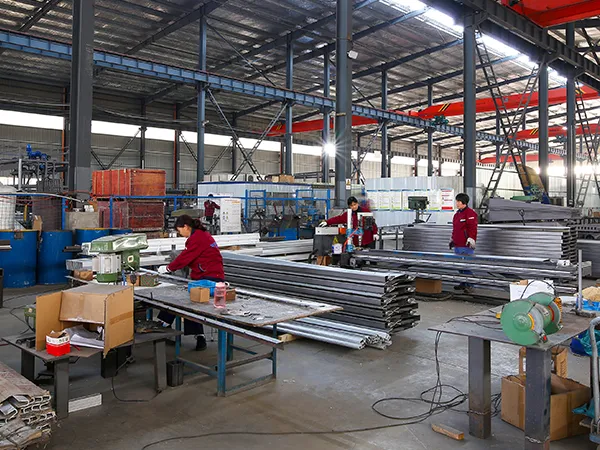
High-Performance Quenching System:
The quenching (rapid cooling) section uses high-pressure air blown through precisely positioned nozzles (top and bottom).
Must deliver powerful, uniform, and controllable airflow across the entire glass surface to create the necessary surface compression for strength and safety fragmentation.
Control over air pressure, nozzle distance, and potentially oscillating patterns is needed to optimize quenching for different glass thicknesses and types, minimizing distortion.
Capability to Process a Wide Range of Thicknesses:
Architectural applications use glass from typically 3mm or 4mm (e.g., interior partitions) up to 19mm or even 25mm (e.g., structural elements, facades). The furnace must be flexible enough to effectively heat and quench this entire range. Thinner glass heats/cools quickly and is prone to distortion; thicker glass requires longer cycles and powerful, uniform heating/cooling.
High Optical Quality Output:
Architectural glass demands excellent optical quality with minimal distortion. The furnace design and operation aim to minimize:
Roller Wave: Distortion caused by sagging between rollers in the heating section. Minimized by high-quality rollers (ceramic, fused silica), precise alignment, potentially smaller roller pitch, and optimized heating recipes.
Edge Lift: Curling up of the glass edges during heating/cooling. Controlled through furnace design and process parameters.
Overall Bow/Warp: General flatness deviation.
Haze or White Spots: Can result from improper heating or quenching, or issues with rollers/insulation.
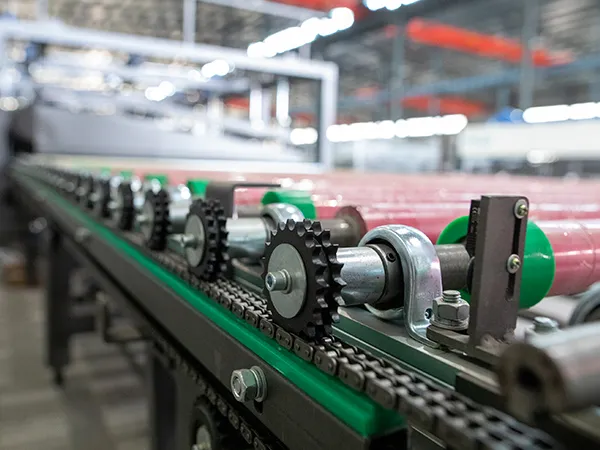
Sophisticated Control Systems (PLC/PC Based):
Manage complex heating and quenching recipes tailored to glass type, thickness, size, and coating.
Provide real-time monitoring of all process parameters (temperatures, pressures, speeds, positions).
Offer diagnostics, alarm management, and data logging for quality control and troubleshooting.
Often feature graphical user interfaces for ease of operation.
Energy Efficiency:
Given the large size and high temperatures, energy consumption is significant. Modern furnaces incorporate:
High-quality thermal insulation (e.g., multi-layer ceramic fiber) to minimize heat loss.
Efficient heating element design and control.
Optimized convection systems that improve heat transfer efficiency, reducing cycle times.
Sometimes, heat recovery systems (though less common than basic efficiency measures).
Reliability and Robustness:
Designed for continuous or near-continuous operation in a demanding industrial environment.
Use of durable materials for rollers, insulation, heating elements, and mechanical components.
Features that facilitate maintenance (e.g., access to components).

Furnace Type (Oscillating vs. Continuous):
Oscillating Furnaces: Glass moves back and forth within the heating chamber. Generally more flexible for handling various sizes, thicknesses, and complex loads (like coated glass). Often preferred for architectural glass due to product mix variability.
Continuous Furnaces: Glass moves in one direction through distinct heating zones and into the quench. Better suited for very high volume production of standardized sizes but can be less flexible.
In summary, architectural glass tempering furnaces are large, technologically advanced machines focusing on uniform heating (especially via convection for coated glass), precise quenching, and sophisticated control to produce high-quality, flat, and safe tempered glass across a wide range of sizes and thicknesses demanded by the construction industry.









